Social Security benefits over the next 75 years will exceed payroll tax revenues by $4.6 trillion. To close this enormous fiscal gap, one proposal is to cut the benefits of high-income workers. Many low-income workers depend almost entirely on Social Security for their retirement income, but it is often assumed that high-wage workers can maintain their standard of living without Social Security benefits due to their private pensions and savings. Surprisingly, however, even high-wage workers depend on Social Security for a substantial portion of their retirement income and would significantly change their consumption and saving behavior in the absence of Social Security. Specifically:
- Social Security accounts for virtually all of the discretionary consumption of households with modest preretirement incomes (less than $50,000 a year for couples or $25,000 for singles).
- It is equal to about one-third of the consumption of the highest-earning households (couples with preretirement incomes of $500,000 and singles with $250,000).
This study is based on modeling of representative households. Living standards are measured by the dollars available for discretionary consumption after subtracting such “off the top” expenditures as taxes, contributions to tax-favored savings, mortgage payments, college tuition and life insurance premiums. The model assumes that, other things equal, people will try to maintain their standard of living by evening out their consumption over their remaining lifetimes.
There are two ways people can smooth their lifetime consumption: 1) They can borrow in order to increase their current consumption, or 2) They can save in order to increase their future spendable income. Borrowing requires them to lower their future standard of living (as they pay back the debt), while saving requires them to lower their current standard of living (by cutting spending). However, this is difficult for lower income people. Due to their current obligations, they often cannot increase their retirement savings. Also, they are limited in their ability to borrow in order to increase their current consumption. If Social Security were abolished tomorrow, younger households would have many years to adjust, but only the wealthiest would be able to spread the loss of Social Security benefits evenly over the whole of their remaining lives. The high-earners would reduce their consumption by about 18 percent for every remaining year of life.
People with less income could not adjust fully to the loss of Social Security benefits by reduced consumption and increased savings. As a result, they would face substantial reductions in their living standards at retirement:
- If Social Security were abolished tomorrow, 35-year-old couples with annual incomes of $200,000 would reduce their current consumption almost 24 percent; but at retirement, they would have 39 percent less discretionary consumption than under the current system.
- Singles earning $100,000 a year would reduce their current consumption about 16 percent; but at retirement they would have about 42 percent less.
What about a less drastic cut in benefits? In the face of a 30 percent cut in benefits, even the highest-income retirees would reduce their consumption by 11 percent. Low-income retirees would reduce their consumption almost dollar for dollar with the benefit cut.
Although they would have much more time to adjust, younger households at most income levels would make only minor changes prior to retirement. For example:
- Thirty-five-year-old couples earning $20,000 to $200,000 would reduce their current consumption spending by less than one-half a percent if faced with a 30 percent benefit cut; however, they would have 15 percent to 29 percent less discretionary consumption at retirement.
- The highest income couples, earning $500,000 a year, would smooth out their consumption by reducing it by more than 5 percent per year for every remaining year of life.
These results imply that workers at every income level depend substantially on Social Security. If retirement benefits were eliminated for middle-aged workers, only the highest-earning couples would be able to maintain their standard of living pre- and post-retirement. However, many workers with modest incomes would find the necessary adjustments difficult or impossible to make.
[page]The value of projected Social Security benefits over the next 75 years exceeds estimated payroll tax revenues by $4.6 trillion. Clearly, future benefit levels are not sustainable under current law. 2 There are a number of options to close this enormous fiscal gap, including different combinations of Social Security benefit reductions and payroll tax increases.
"High-wage workers depend on Social Security for a substantial portion of their retirement income."
One proposal is to cut the benefits of high-income workers. While it is widely recognized that most low-wage workers depend on Social Security for their retirement income, it is commonly assumed that high-wage workers can maintain their standard of living without Social Security benefits, due to their private pensions and savings. However, even high-wage workers depend on Social Security for a sizable portion of their retirement income. This study analyzes stylized households to examine the degree to which today's workers depend on Social Security to maintain their living standards in retirement. It also shows how they would be affected by the disappearance or reduction of projected Social Security benefits, and how they would change their behavior in response.
[page]This study measures the dependence on Social Security retirement benefits of representative single-parent and married, two-earner households (each with two children who live at home until they enter college), with different levels of expected lifetime earnings, savings and debts scaled to their preretirement incomes. Financial data for these households were entered into ESPlanner ™, a financial planning program, to model the effects on their current and future household living standards if immediate changes in Social Security benefits were announced when they are ages 35 and 65. [See the side bar, “Using ESPlanner ™ to Create Household Profiles.”]
Using ESPlanner™ to Create Household Profiles
ESPlanner™ is a financial planning software program that allows individuals and couples to project how much retirement savings and life insurance they will need to maintain a given standard of living throughout their lives. They input into the program details about their current wages, interest and dividends; payroll and income taxes; living expenses such as mortgage payments and child care; and expectations about the future, such as a college education for their children and the rate of return they hope to earn on their investments. ESPlanner™ estimates their future consumption — income left after subtracting savings, mortgage, taxes and life insurance premiums — and adjusts for inflation. This allows an individual or couple to calculate their highest sustainable living standard over the rest of their lives, taking into account their economic resources, including Social Security benefits.
For this study, ESPlanner™ was used to create financial profiles of seven married and seven single-parent households at age 30 with different income levels, using a number of assumptions about their saving and consumption habits. Each household starts off with specific assets and liabilities scaled to their income level. [For details, see the Appendix.] Each household has two children (who leave when the couple or single parent is older). Given expected increases in earnings and average interest rates, ESPlanner™ determined their assets and liabilities at ages 35 and 65. Each household's consumption was calculated at each age and in the absence and presence of Social Security benefits.
This study focuses on discretionary consumption spending — or discretionary income — as a measure of household living standards. This is income that can be spent (consumed) as the household chooses, after subtracting “off the top” obligatory expenditures for such things as taxes, contributions to tax-favored savings, mortgage payments, college tuition and life insurance premiums. All of a household's income is allocated to either discretionary consumption or obligatory spending, and when discretionary consumption changes, the model automatically adjusts obligatory spending. Discretionary consumption is important for a household's living standards since it includes spending for such things as food and out-of-pocket health care costs. Furthermore, the consumption expenditures required to maintain a household's living standards vary from year to year as children and adults age. The model assumes that “off the top” expenditures are lower in retirement than at younger ages.
"People try to even out their consumption over their lives to avoid drastic changes in living standards."
The cuts are treated as a surprise at the time they are announced. For the singles and couples who are 65 years old at the time of the announcement, their retirement living standards after the cuts are compared to what their retirement living standards would be if they received full, projected Social Security benefits. 3 For the younger households, their current discretionary consumption with and without benefits is compared, and their discretionary consumption at retirement with benefits is compared to their consumption without benefits. These comparisons show the extent to which younger households adjust to the benefit cuts, and thus avoid a severe reduction in their standard of living when they retire. The model assumes that, other things equal, people will try to maintain their standard of living by evening out their consumption over their remaining lifetimes. [See the side bar “Comparison of Consumption Smoothing by Two Couples.”]
For all of these households, the financial impact over their remaining lives was simulated for three policy options:
- Policy Option 1: Social Security benefits under current law are completely paid.
- Policy Option 2: Social Security benefits are immediately and completely eliminated.
- Policy Option 3: There is an immediate 30 percent benefit cut — affecting 65-year-olds who are about to retire as well as younger workers.
In all cases, it is assumed that workers continue to pay Social Security taxes under current law.
Comparison of Consumption Smoothing by Two Couples
Other things equal, people will attempt to smooth consumption over their lifetimes — that is, they will try to avoid abrupt changes in their standard of living. This is the theory underlying the life-cycle model of consumption and saving used in this study. It is also the way people behave. There are two ways people can smooth their lifetime consumption: 1) They can borrow in order to increase their current consumption, or 2) They can save in order to increase their future spendable income. Borrowing requires them to lower their future standard of living (as they pay back the debt), while saving requires them to lower their current standard of living (by cutting spending). However, this is difficult for lower income people. Due to their current obligations, they often cannot increase their retirement savings. Also, they are limited in their ability to borrow in order to increase their current consumption.
For example, take two young couples starting out. The first couple consists of two credit-worthy, middle-income earners who can finance some of their current consumption by borrowing. For credit-worthy, higher-income couples, the cost of borrowing will be lower than the rate of return on their retirement savings. During their retirement years, they live on the savings accrued during their working years in addition to Social Security benefits. Borrowing and saving allows them to smooth their consumption
over their remaining lives.
The second young couple earns less and cannot finance current consumption by borrowing against their future income. The reason is that the cost of additional borrowing would be greater than the rate of return they would receive on their savings. In other words, they are borrowing constrained due to their existing debt obligations. They save less, but due to the progressive Social Security benefit formula, they expect a retirement standard of living that is higher than their current standard of living.
If Social Security benefits were cut 30 percent, the first couple, which is not borrowing constrained, would reduce their current consumption in order to save more — lowering their current standard of living in order to avoid a large reduction in living standards at retirement. The second couple, which is borrowing constrained, would reduce their current consumption very little, if at all — even though a 30 percent cut in Social Security benefits represents a greater percentage of retirement income for them than it does for the first couple. The reasons: 1) The cut would not drastically reduce their retirement living standards below their current living standards, and 2) They cannot borrow against their Social Security benefits. If Social Security benefits were completely eliminated, however, the second couple would face a drastic decline in their living standard at retirement; in response, they would reduce their current consumption in order to save more.
[page]
"Changes in Social Security would not only affect households' retirement living standards, but their current consumption as well."
Policymakers are not seriously considering completely eliminating Social Security. But in order to demonstrate that Americans at all income levels depend on Social Security, the model was used to answer the hypothetical question: What would happen to households at different income levels if Social Security benefits were simply to disappear? Analysis of the representative households modeled for this study shows that the elimination of Social Security would not only affect households' living standards in retirement, but their current consumption as well.
"Social Security replaces more preretirement income for lower-wage workers than for higher-wage workers."
Effects of a 100 Percent Benefit Cut on Households Approaching Retirement. Figure I shows the full annual Social Security benefits representative households at different income levels expect to receive under current law. 4 If Social Security benefits were eliminated, retiring 65-year-olds would have no time to prepare. They would immediately reduce their discretionary consumption in reaction to the loss of retirement income, by 35 percent for the highest earners up to 100 percent for the lowest-earning households. 5 This represents a drastic reduction in living standards for all the households. The loss of benefits would also affect the obligatory spending of all of the households; however, they all have some asset income on which to rely for obligatory spending. As Figure II shows:
- With full Social Security benefits and their own retirement savings, the 65-year-old couple with a preretirement income of $200,000 would have $55,247 in annual discretionary consumption in retirement; but without Social Security benefits they would have only $12,204, or 78 percent less.
- The couple with a super-high preretirement income of $500,000 would have $108,454 available annually for discretionary consumption with Social Security; but without benefits they would have only $69,854, or almost 36 percent less.
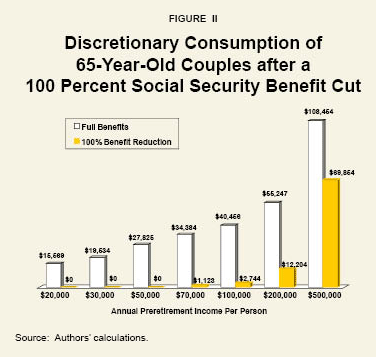
"Without Social Security, high income retirees would cut their consumption by more than one-third."
Figure III shows that the percentage reductions in the consumption of single 65-year-olds are similar to the reductions for couples with comparable incomes:
- The single 65-year-old with a preretirement income of $100,000 would have $29,279 a year in discretionary consumption with full benefits; but without Social Security would have only $6,953, or about 76 percent less.
- The wealthier single with a preretirement income of $250,000 would have discretionary consumption of $49,691 with full benefits; but without Social Security would have about $30,147, or 40 percent less.
But how can it be that such high-earning households depend on Social Security for so much of their retirement consumption? It is not for lack of saving: In the simulation, the couple earning $500,000 arrives at age 65 with $2.3 million in assets. This may seem like a lot of money, but potentially it must finance 35 years of retirement. 6 The simulations assume the household earns a pretax real return on these assets of only 3 percent; 3 percent of $2.3 million is just $69,000 a year. 7 Lower-income seniors would face much greater reductions in their discretionary spending. For example, the simulations show that absent Social Security, 65-year-old couples with preretirement incomes of $20,000 to $50,000 and single households with incomes of $10,000 to $25,000 would have no income for discretionary consumption!
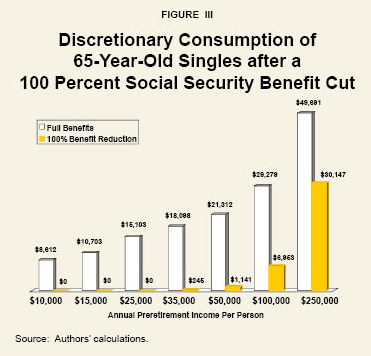
"Low-income retirees would lose virtually all of their discretionary consumption."
If Social Security disappeared tomorrow, the consumption of retirement-age households of all income levels would decline significantly, demonstrating that almost all households depend on Social Security — even the very wealthy.
"Younger workers would have many years to adjust to changes in Social Security."
Effects of a 100 Percent Benefit Cut on Younger Workers. Younger households would have decades to adjust to the disappearance of Social Security by reducing their current consumption in order to increase their savings rate. But lower-income households cannot fully smooth their consumption (as discussed in the side bar). Thus their retirement living standards will be much lower without the income they had anticipated from Social Security. Tables I and II show the reduction in current consumption of 35-year-old households resulting from Social Security cuts.
Among 35-year-old couples, for example [see Table I and Figure IV]:
- Those with annual incomes of $100,000 would reduce their current consumption almost 23 percent, from $43,860 to $33,905.
- At retirement, however, they would still have much less income available for discret ionary consumption than with full benefits; instead of the $43,276 annually they expected, they would have only $23,660, or 45 percent less.
- Couples with annual incomes of $200,000 would reduce their current consumption almost 24 percent, from $74,508 to $56,781; but at retirement, they would have only $39,622, or 39 percent less, in discretionary consumption.
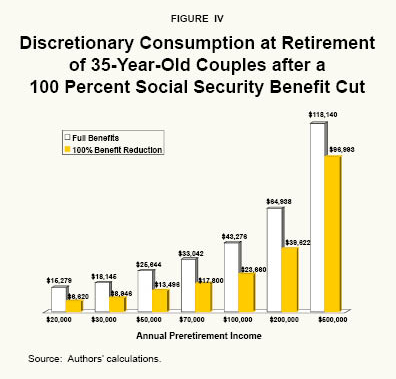
"It would be difficult for couples to adjust to the disappearance of Social Security."
The single-parent households closely mirror the couples [see Table II and Figure V]:
- Singles earning $50,000 a year would reduce their current consumption almost 16 percent, from $24,918 to $20,966; but at retirement, instead of the discretionary income they expected with full benefits, they would have only $11,580, almost 50 percent less.
- Singles earning $100,000 a year would also reduce their current consumption about 16 percent, from $42,456 to $35,516; but at retirement they would have only $19,616 for discretionary consumption, about 42 percent less.
"Retirement living standards would be much lower for all but the wealthiest 35 year olds."
What do these numbers mean? They mean that these younger individuals and couples are unable to smooth their consumption over their remaining lives in response to the elimination of Social Security. This is shown by the fact that the percentage reduction in their discretionary consumption at retirement is much greater than the fall in their current consumption.
Young, wealthy couples and singles, however, would be able to spread the loss of Social Security benefits over the whole of their remaining lifetimes, smoothing their consumption:
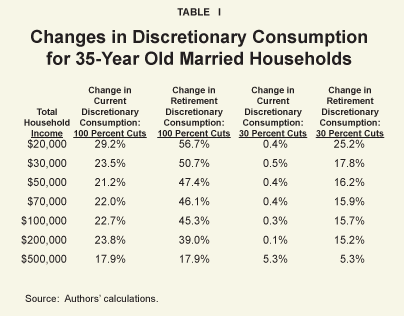
- Couples earning $500,000 would reduce their current consumption at age 35 from $169,301 to $138,996, or about 18 percent, and at retirement would also have about 18 percent less discretionary consumption than with full benefits ($96,993 and $118,140, respectively).
- Similarly, the wealthiest singles, earning $250,000 a year, would reduce their current consumption 18 percent, from $100,414 to $82,786, and at retirement would also have about 18 percent less discretionary consumption than with full benefits ($45,724 and $55,460, respectively).
"Only the wealthiest couples would be able to spread the loss of benefits over the whole of their remaining lifetimes."
By doing so, they avoid drastic changes in their discretionary consumption over their remaining lives.
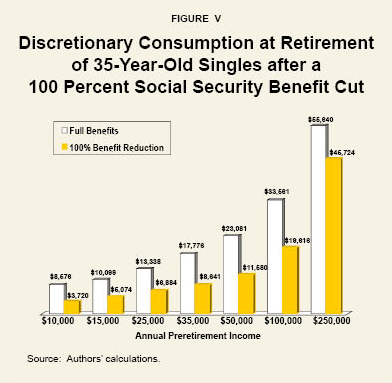
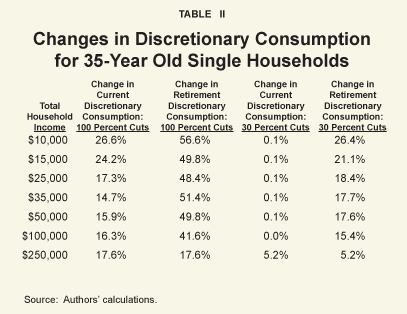
"A 30 percent cut in Social Security benefits would substantially reduce the retirement income of 65 year olds."
A reduction in benefits — particularly the benefits of higher-income households — is possible to balance Social Security's large projected deficits. As expected, even small cuts would reduce the living standards of low earners. But the highest earners will also be affected.
Effects of a 30 Percent Benefit Cut on Older Households. A 30 percent cut in benefits would significantly affect all 65-year-old households approaching retirement because they would have little time to compensate through additional saving. Indeed, the reductions in consumption of these older households would range from 11 percent for the highest-income households to 32.2 percent for low-income households. For example [see Figure VI]:
- The couple with a preretirement income of $100,000 a year who would have had $40,456 in discretionary consumption at retirement with full Social Security benefits would have only $29,541, or 27 percent less discretionary consumption.
- The couple with a preretirement income of $200,000 who would have had $55,247 in discretionary consumption at retirement would have only $42,989, or 22 percent less.
- Finally, the couple with a preretirement income of $500,000 who would have had $108,454 in discretionary consumption at retirement would have only $97,087, 11 percent less.
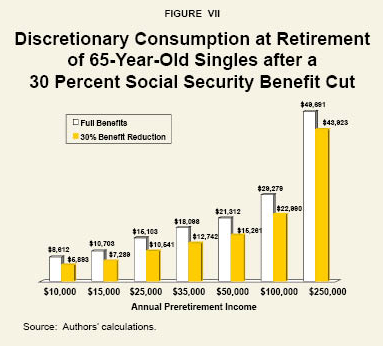
Like the couples, 65-year-old singles would have less discretionary retirement consumption [see Figure VII] with the 30 percent benefit cut:
- The single with a preretirement income of $50,000 a year who would have had $21,312 in discretionary consumption at retirement with full benefits would only have $15,261, about 28 percent less.
- The single with a preretirement income of $100,000 a year who would have had discretionary consumption of $29,279, will have only $22,990, almost 22 percent less.
- The single earning $250,000 a year who would have had discretionary consumption of $49,691 will have only $43,923, about 12 percent less.
"Younger households would reduce their current consumption spending very little to increase their savings."
Effects of a 30 Percent Benefit Cut on Younger Households. The effect of the announced benefit cuts on current living standards depends a lot on the age of the household. The 35-year-old households have decades to compensate for a reduction in Social Security benefits by increasing their savings. But they reduce their current consumption by very little. The reason for this is that couples with annual incomes of less than $100,000 are borrowing constrained [see the sidebar on Smoothing Consumption]. They cannot reduce their current consumption by much in order to increase their savings rate. 8 As a result, they will experience a larger reduction in their retirement standard of living than if they had been able to reduce their current consumption when younger. In fact, with the exception of those earning $500,000 a year, at age 65 all income levels will have at least 15 percent less discretionary consumption than they would otherwise. Only the top income earners will face minimal reductions in their retirement standard of living.
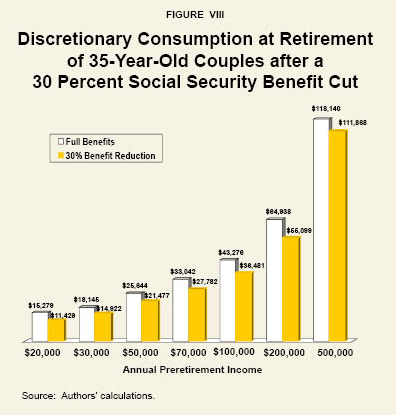
Among 35-year-old couples [see Table I and Figure VIII]:
- Couples with annual incomes of $100,000 would reduce their current consumption only three-tenths of one percent, from $43,860 to $43,710!
- At retirement, these couples would have $36,481 annually for discretionary consumption, almost 16 percent less than the $43,276 they would have had with full benefits.
- Couples earning $200,000 a year would reduce their current consumption only one-tenth of one percent, from $74,508 to $74,402.
- But at retirement, these couples would have $55,099 in discretionary income, about 15 percent less than the $64,938 they expected.
"Younger couples at most income levels would face a reduction in their living standards at retirement."
However, 35-year-old couples with annual incomes of half a million dollars would reduce their current consumption by about 5 percent — more than any other income level — from $169,301 to $160,313. At retirement, they would have $111,868 in discretionary income, only 5 percent less than the $118,140 they would have had for discretionary consumption with full benefits. Thus, they are able to spread the loss of their Social Security benefits over their remaining lives.
For 35-year-old single earners [see Table II and Figure IX]:
- Those with annual incomes of $50,000 would reduce their current consumption only one-tenth of one percent, from $24,918 to $24,904.
- At retirement, these singles would have $19,008 in discretionary income, about 18 percent less than the $23,081 they would have had available to consume with full benefits.
- Singles with annual incomes of $100,000 would not reduce their current consumption at all, but maintain it at $42,456 a year.
- At retirement, they would have $28,400 in consumption income, 15 percent less than the $33,561 they would have had with full benefits.
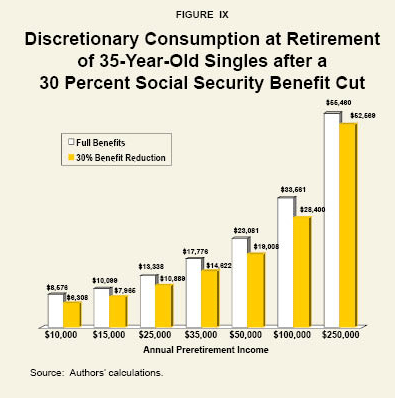
"Only the wealthiest young individuals would fully adjust to 30 percent benefit cuts."
Finally, the highest-earning singles, with annual incomes of $250,000, would reduce their current consumption 5 percent, from $100,414 to $95,179. At retirement, they would have $52,569 to consume, only about 5 percent less than the $55,460 they would have consumed with full benefits.
[page]"Bottom line: Americans at most income levels depend on Social Security."
Reductions in projected benefits for younger workers — particularly for higher earners — are increasingly likely as time passes and no substantive solutions are enacted. The implications of the above scenarios for Social Security reform must be carefully examined. The bottom line is that Americans at most income levels depend on Social Security. Younger, lower-income households that cannot borrow or reduce their current consumption would experience a much greater decline in their retirement standard of living if benefits were cut. But even many higher earners would face lower retirement living standards. Making changes in Social Security now to be implemented in the future would give workers time to adjust their current levels of consumption and retirement savings. However, many workers are unprepared to make the necessary adjustments.
NOTE: Nothing written here should be construed as necessarily reflecting the views of the National Center for Policy Analysis or as an attempt to aid or hinder the passage of any bill before Congress.
[page]- Based on the study by Laurence J. Kotlikoff, Ben Marx and Pietro Rizza, “Americans' Dependency on Social Security,” National Bureau of Economic Research, Working Paper No. 12696, November 2006.
- The 2006 Annual Report of the Board of Trustees of the Federal Old-Age and Survivors Insurance and the Federal Disability Trust Funds.
- This may be an unrealistic assumption, since the future benefits promised today's workers are unsustainable. Without substantial payroll tax increases or an infusion of general tax revenues, today's younger workers are unlikely to receive all the benefits “promised” under current law.
- Singles with incomes of $250,000 have the same expected Social Security benefits as singles with incomes of $100,000. Couples with incomes of $500,000 and $200,000, respectively, receive the same Social Security benefits. This is because the amount of taxable wages, and therefore the amount of benefits an individual can accrue, are capped; in 2005, for example, the payroll tax cap was $90,000. The model assumes the dollar amount of earnings subject to Social Security payroll taxes increases by 1.1 percent (in real terms) annually.
- Note that the percentage reduction in consumption for any of the households is likely different from the proportion of total retirement income their full Social Security benefits represent. That is because many variables change in response to the loss of benefits, including the amount of savings, life insurance and taxes. For example, higher income seniors may pay less income taxes since their Social Security benefits were likely taxable (the so-called benefits tax).
- The real rate of return is based on a 7 percent nominal rate of return in non-equity funds (bonds) minus inflation and estimated taxes.
- According to the Social Security Administration, some 90 percent of current retirees rely on Social Security for half or more of their retirement income. For one-in-five households, Social Security is their only source of retirement income. Social Security Administration, “Fast Facts & Figures about Social Security, 2005.” Available at http://www.ssa.gov/policy/docs/chartbooks/fast_facts/2005/index.html.
- They may increase their savings in later middle age. For examples, see the simulations for 50 year olds in Laurence J. Kotlikoff, Ben Marx and Pietro Rizza, “Americans' Dependency on Social Security.”
Characteristics of Representative Households
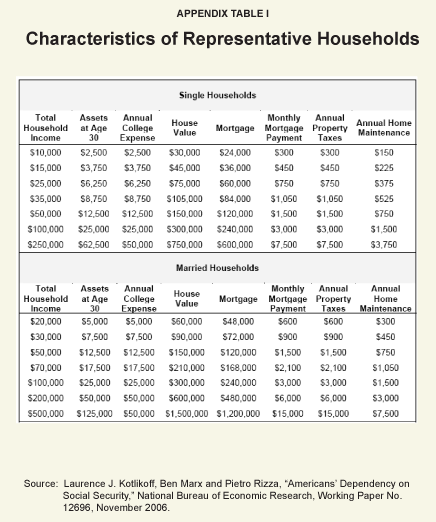
ESPlanner ™ was used to simulate 14 representative households with specific characteristics. Seven are single-parent households and seven are married couples. All begin with two children, born when their parents are ages 27 and 29. It is assumed that each household's labor earnings remain fixed in real dollars through time, investments earn a 3 percent real return (absent inflation and taxes), and each married and single adult lives to age 100. [See Table A-I.]
For example, in Table A-I, consider the single-parent household with annual earnings of $50,000. At age 30, initial assets (stocks, bonds, savings and checking accounts) are assumed to be valued at $12,500. Annual college expenditures are $12,500 per child, and the household's mortgage balance is $120,000 with a $1,500 monthly payment, $1,500 in annual property taxes, and $750 in annual home maintenance expenses. The assets, remaining mortgage balance and remaining college expenditures are extracted for this household at ages 35 and 65. The values for all the ages are then run separately in ESPlanner ™. Furthermore, each age is modeled with no Social Security benefit cuts, 30 percent benefit cuts and 100 percent benefit cuts.
With the exception of a $50,000 ceiling per household on college expenses, the non-earnings entries for the other households are scaled by their levels of earnings. For example, the households earning $100,000 annually have initial assets at age 30 of $25,000, twice the initial assets of the households earning $50,000.
[page]Laurence J. Kotlikoff , a senior fellow with the National Center for Policy Analysis, is a professor of economics at Boston University, research associate of the National Bureau of Economic Research, fellow of the Econometric Society, a member of the Executive Committee of the American Economic Association and president of Economic Security Planning, Inc., a company specializing in financial planning software. Prof. Kotlikoff received his Bachelor of Arts degree in economics from the University of Pennsylvania in 1973 and his Doctor of Philosophy degree in economics from Harvard University in 1977. From 1977 through 1983 he served on the faculties of economics of the University of California – Los Angeles and Yale University. In 1981-1982 Prof. Kotlikoff was a senior economist with the President's Council of Economic Advisers. Prof. Kotlikoff is coauthor (with Scott Burns) of The Coming Generational Storm; coauthor (with Alan Auerbach) of Macroeconomics: An Integrated Approach and Dynamic Fiscal Policy ; author of Generational Accounting and What Determines Savings? ; coauthor (with Daniel Smith) of Pensions in the American Economy ; and coauthor (with David Wise) of The Wage Carrot and the Pension Stick . In addition, he has published extensively in professional journals, newspapers and magazines.
Ben Marx was a research assistant to Prof. Laurence J. Kotlikoff at Boston University and is now a first-year student graduate program for a Doctor of Philosophy degree in economics at Columbia University.
Pietro Rizza is an economist with the Bank of Italy and a candidate for a Doctor of Philosophy degree in economics at Boston University.